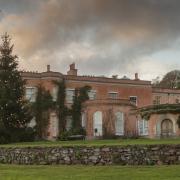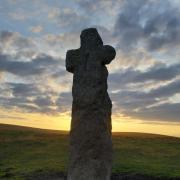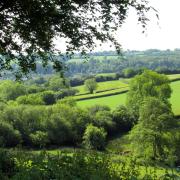The recent discovery of Earth’s oldest fossilised forest on the North Devon and Somerset coast is a reminder that trees, in all their abundant glory, have graced this world for millennia before anything resembling humans ever existed. This ancient forest, which was very different to the kind of forest we know, was growing something around 390 million years ago – our early human ancestors first appeared roughly six million years ago. Yet the impact of humanity on the life of trees is sobering.
Were it not for our activity, present-day Britain would be much more densely wooded: oak, ash Scot’s pine… the species would vary with the region, but all are a vital part of the healthy environment of this planet, something upon which all life depends.
Trees’ lifecycles are complex and the science is not for this feature, but our ancestors revered trees and as we move towards autumn, when their vibrancy of colour starts to catch our attention, it’s a good time to celebrate some of the stories around our living heritage and to remember what we owe to trees.

The oak is an obvious starter. Rich in biodiversity and easily recognised, it’s often regarded as the epitome of English solidity - the Latin name of the English oak, Quercus robur, alludes to its robust strength. The legend connecting Crediton’s St Boniface with the pagan worship of oaks, and how this gave rise to our tradition of Christmas trees, is a lesser-known aspect of the oak’s story.
In the eighth century Boniface worked as a missionary in Germany, where there once grew an oak, known as Thor’s Oak. At this tree human sacrifice took place and Boniface, in a theatrical attempt to thwart the heathen during a mid-winter ritual, felled the oak before the assembled crowd.

Druids in Celtic Britain worshipped oaks and they are woven into the fabric of myth and history: the Major Oak of Sherwood Forest is inextricably linked with the story of Robin Hood, and Charles ll reputedly hid in oaks when escaping Cromwell’s attention, including one at Meavy on Dartmoor, which is probably one of the most venerable oaks in Devon – the Ancient Tree Forum says it’s estimated to be 900 years old.

Another well-known and abundant tree, the ash, is far less abundant than it once was due to the ash dieback that we hear so much about. Various factors, including the ash’s genetic diversity, indicate that some are more resistant and could survive, giving a glimmer of hope for the future population of ash trees.
Ashes, like oaks, were worshipped and in Norse mythology the god Odin was said to have carved the first man from a piece of ash wood. Yggdrasil, the ‘World Tree’ of Viking mythology, is remarkable both for the fact that my spellchecker doesn’t challenge it, and also for having roots reaching into the pits of hell and branches touching the highest realms of heaven.
Burning ash logs guarded against evil spirits and the tree was thought to have curative properties. Gilbert White, in his Natural History of Selborne, describes the superstitious belief prevalent before his time that ash trees, having had their trunks cleft, could cure ‘ruptured children... pushed through the apertures’. It was believed that, once the tree was bound up again, if the cleft healed the child would also be healed.
More believable is the tradition of planting ash trees near castles during the Middle Ages to ensure a supply of lances and spears – ash wood is strong and pliable and is excellent for furniture making. Ash trees also support a huge range of biodiversity, although not as much as oaks.

The elegant and easily recognisable silver birch is a tree whose curative properties have a scientific basis, as birch, like willow, contains salicylic acid from which aspirin is derived. Priestlands Birch is a company based just over the border in Somerset that respectfully harvests from birch trees – the leaves are ingredients in its skincare range, used on sensitive skins.
Having drunk the smooth and immaculate-tasting sap tapped from birches, I can vouch for the beautiful slivery delicacy of its taste. This traditional drink, once supped by Druids to celebrate the spring equinox, is still enjoyed in parts of eastern Europe and is becoming better-known in the UK – something I recommend discovering. Years ago a friend of mine made a sublime silver birch sap wine, much to the puzzlement of his neighbours who regarded the demijohns round the trees in his Birmingham garden with some suspicion.
Despite their rather fragile appearance birch trees are hardy and would have been one of the first species of tree to pioneer land after the last Ice Age receded.

The smooth bark and towering arboreal vaulting of our majestic, ‘common’ beech is thought to have inspired cathedral architecture; there is something naturally sacred about the space beneath them. The bright green of vernal beech ‘pennies’ is a striking contrast to their lush autumn colours and in folklore the beech is regarded as the queen of trees, the king being the oak.

Magnificent as a tree, beech is also popular for hedging, and can be pretty awesome here too: the Meikleour beech hedge in Perthshire, planted in 1745, is the highest hedge of its kind in the world at over 100ft, and is also the longest hedge in Britain.

The hawthorn is living proof that you don’t have to be big to be brilliant. Also known as ‘may’ or ‘quickthorn’, this is another tree to have ancient associations with paganism, early Christianity and ‘other-worldliness’.
In the modern world, parts of the tree are known to possess powerful medicinal properties and can be used as a heart tonic, to treat high blood pressure and cholesterol, amongst various other conditions (always consult a qualified medical herbalist). I recall my grandmother showing me that young hawthorn leaves, called bread-and-cheese, are edible and that the berries or haws, which are rich in vitamin C, taste a bit like apple – but spit out the seeds.
Like other trees, hawthorns are wonderful for wildlife: the haws are beloved by many birds and small mammals, and the small white flowers are vital for pollinators including honeybees – listen for the zizzy hum of insects. The dense, thorny canopy also provides a protective nesting site.

So, cherish what we have – and plant more. Treat them with the wisdom they deserve, and join the Woodland Trust. Without trees we couldn’t survive.



























